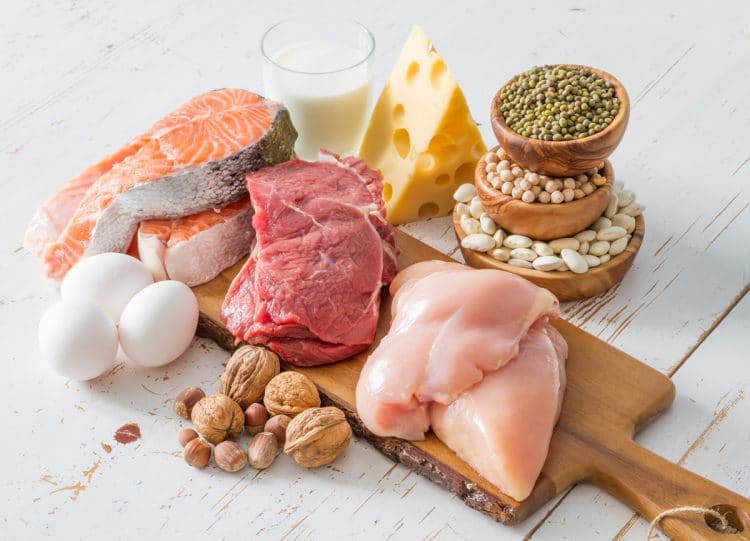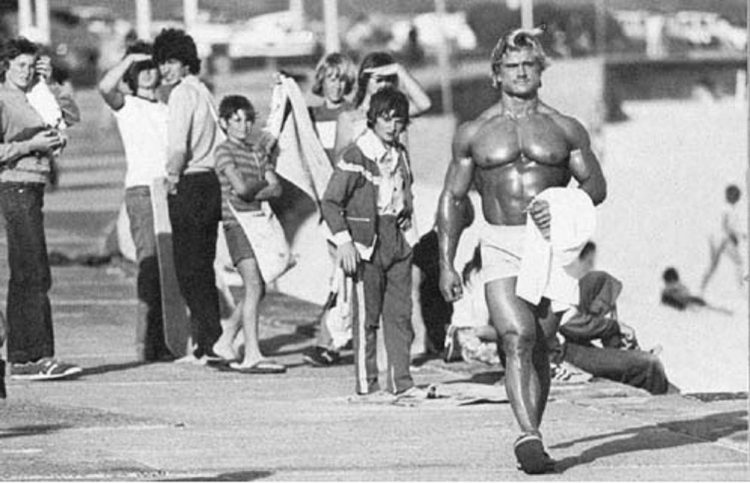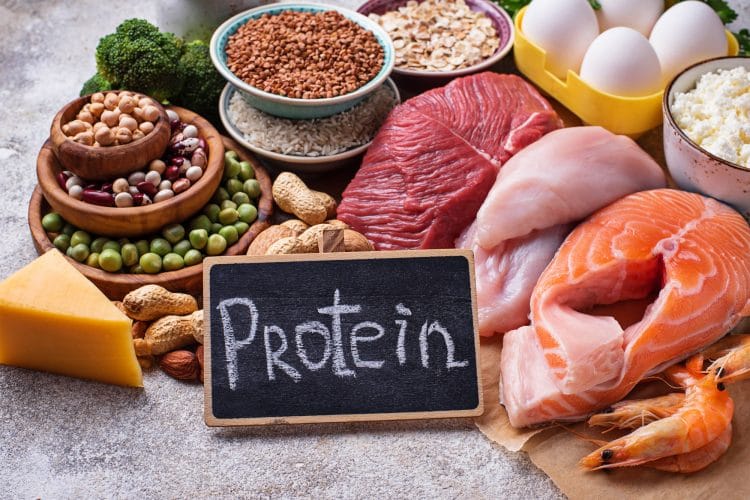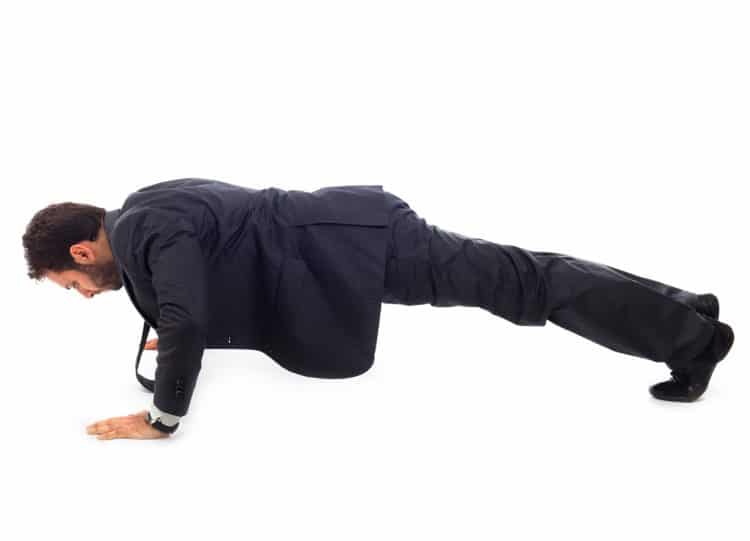A lot of people look slim but, when they take off their shirts, they have a prominent belly. They may also have soft, flabby arms and legs. This is often referred to as being “skinny fat”. People who are skinny fat can look fit and healthy from afar but, when you see them up close, they lack any obvious muscle mass or definition.
Someone who is skinny fat probably won’t be very strong, but they may be cardiovascularly fit. They may do a lot of cardio but probably don’t do a lot or any strength training.
Skinny fat people may be the correct weight for their height, scoring a “normal” body mass index (BMI) reading. However, if you checked their body fat percentage, it would actually be quite high.
In this article, we reveal the causes of skinny fat and lay down an eight-point action plan for fixing this common problem.
What is Skinny Fat?
People who are skinny fat are often relatively slender. However, despite not being significantly overweight or obese, they’re still carrying excess body fat. This is because they lack muscle mass.

Muscle mass is very dense, and if you have too little, you can be slender AND carry too much body fat at the same time. This means your weight may be perfectly normal, even though much of that weight is made up of fat.
Many skinny fat people find this concept hard to grasp as we’re often told that our body weight is an important indicator of health. That’s why a lot of exercisers diet hard and do a lot of cardio to lose weight, but still end up being skinny fat.
However, just because the scales tell you that everything is alright doesn’t mean it is. In many cases, the mirror is a much more helpful tool.
Skinny fat people often accumulate fat around their stomachs and have very prominent bellies. In fact, some thin but fat people have very little fat on their arms and legs; it’s all concentrated around their midsection. If you have no problem squeezing your legs into skinny jeans but can’t do up the waist button, there is a good chance you are skinny fat.
What Causes Skinny Fat?

Being thin with belly fat and skinny fat are common problems with several causes. Identifying the causes of these problems will make them easier to fix. The leading causes are:
Consuming too many calories – the most apparent cause of fat gain is eating too much. Your body needs energy to function, and we get that energy from food. The energy in food is measured in calories. If you supply your body with more calories than it can use, you create a surplus. That surplus is converted into fat and stored for later use.
For example, if you need 2,000 calories per day but consume 2,200, you have 200 more than you need. Multiply that by seven days, and you could potentially create a 1,400-calorie surplus, or slightly less than half a pound of fat.
Depending on factors like genetics, gender, activity levels, and age, this fat could end up being stored preferentially around your midsection.
Fat stored around your belly is linked to a range of health issues, including (1):
- Heart disease
- Hypertension
- Type II diabetes
- Cancer
- Hormonal abnormalities
- Premature death
Sedentary lifestyle – movement burns calories and can help eliminate the calorie surplus described above. But, physical activity does more than just burn calories; it also determines where the calories you eat end up.
This is called nutrient partitioning.
If you are active, the calories you consume are more likely to be portioned (sent to) your muscles and liver. Those same calories are more likely to be partitioned in your adipose tissue or body fat if you are sedentary.
Modern life has become increasingly sedentary, and for many people, physical activity is entirely optional. Desk jobs, mechanized transport, and passive entertainment like TV and video games that it’s all-too-easy to go for weeks, months, or years without doing any meaningful movement.
Even regular exercisers are at risk of being sedentary. There are 168 hours in a week, and most people only work out for 4-6 hours. This adds up to a measly 3.5% of physical activity per seven days.
Nutrient partitioning is something you can control so that your body is more likely to direct the calories you eat away from your fat cells and into your muscles. How? By implementing the strategies elsewhere in this article!


Too much cardio – when it comes to burning body fat and losing weight, many exercisers turn into cardio fiends! While cardio DOES burn fat and can help create a calorie deficit, doing too much can also lead to less muscle mass. If you lose fat AND muscle, your body composition will not change much, even if you lose weight.
Cardio can help you lose weight and get leaner, but it’s a question of use versus abuse. Too much cardio could be detrimental to your goal.
Severe calorie restriction – common sense suggests that you need to eat less if you want to lose fat. However, if you cut calories too aggressively, you’ll end up losing muscle and fat at the same time. Your scale weight will decrease, but the relationship between muscle mass and body fat percentage will remain relatively unchanged (2).
Most fad and crash diets cut your caloric intake too much. Not only are these diets unsustainable in the long-term, but they also lead to muscle loss.
The result? Skinny fat!
Because of this, most skinny fat people should avoid very restrictive diets. Instead, a more sustainable, less aggressive nutritional approach works best.
Not eating enough protein – a protein deficiency means your body won’t have the building blocks it needs for muscle repair and growth. Without adequate protein, your body will start to lose muscle because it doesn’t have the raw materials necessary for muscle preservation. As muscle levels decline, body fat levels increase.

Losing muscle can also reduce your basal metabolic rate, or BMR for short, which is the number of calories you need per day. Muscle is metabolically active tissue, which means it uses energy. Losing muscle means your body needs fewer calories, and if you don’t eat less, this will create a more significant calorie surplus.
Eating too much sugar and refined carbs – sugar and refined carbs give you energy, and they can taste good too. However, when you eat them, your body has to produce a large amount of insulin. In simple terms, insulin effectively removes the resulting glucose from your blood and drives it into your cells.
Unfortunately, insulin also blocks fat burning, and any glucose that is surplus to your needs is shunted into your fat cells instead. People who have a high percentage of body fat are also more likely to be “insulin resistant,” which means glucose is more easily converted into fat.
Sugar and refined carb consumption have increased significantly over the last few decades, and so too has being overweight and obese. This is not a coincidence!
How to Cure Skinny Fatness in Eight Steps
The good news is that being skinny with a fat belly is very curable. That doesn’t mean it’s easy, but with time, energy, and effort, you can go from being skinny fat to having a fit, healthy, athletic body.
However, there is no one-hit fix. Curing skinny fatness requires a holistic, long-term approach to exercise, nutrition, and lifestyle changes.
1. Build muscle with strength training


Lifting weights will fix the “skinny” part of being skinny fat. Bigger muscles will help sculpt a more athletic-looking physique. This doesn’t mean you have to take up bodybuilding or powerlifting, but you do need to get in the gym and start challenging your muscles to grow and get stronger.
There are lots of different approaches you can use to achieve your goals, including:
Whatever you do, you should aim to train 3-4 times per week. Not only will this increase your muscle strength, size, and tone, it will also improve nutrient partitioning.
After exercise, your insulin sensitivity is turned up to the max, so the food you eat is more likely to be directed toward your muscles and away from your adipose tissue. This effect lasts anywhere from 16-24 hours (3).
2. Use (but don’t abuse) cardio


Cardio can help create the caloric deficit that leads to fat burning. However, it’s important not to do so much that you end up losing muscle mass too. For most skinny-fat exercisers, this means short, intense cardio workouts are better than long, endurance workouts.
2-3 cardio 20 to 30-minute workouts should be all you need, and if you feel you need to do more, you’re probably eating too much. Eat a little less to eliminate the need for excess cardio.
Good cardio options include:
3. Do more NEAT

NEAT stands for Non-Exercise Activity Thermogenesis and is the antidote to being sedentary. NEAT can be almost anything that gets you up off your butt and moving. Any physical activity that isn’t a workout is NEAT and is a crucial factor for long-term weight management (4).
Common examples of NEAT include:
- Walking
- Taking the stairs and not the elevator
- Mowing the lawn
- Washing your car
- Raking leaves
- Shoveling snow
- Playing with your kids
- Cycling for transport
- Taking out the trash
- Carrying your groceries
- Cleaning
- Breaking up long periods of sitting with a mini-circuit of push-ups and squats
The simplest way to get and keep track of NEAT is by walking. Use a pedometer app and try to accumulate 10,000 steps per day. This is roughly equal to five miles. That might sound like a lot, but it doesn’t have to be done in one session.
For example, you could:
- Walk 15 minutes before breakfast
- Walk 30 minutes at lunchtime
- Walk 15 minutes after dinner
- Park your car a few minutes from your destination and walk the difference
- Leave your car at home for journeys of less than a mile
NEAT shouldn’t be tiring, won’t cause muscle breakdown, and should be easy to fit into your day. However, if you are mostly sedentary, it can help you burn more calories and lose fat.
4. Eat more protein

If you are skinny and have a belly, you will probably benefit from eating more protein. Protein will help preserve your existing muscle mass, provide the nutritional building blocks needed to increase muscle mass, ward off hunger, and increase your metabolic rate.
How much protein you need to consume is up for debate, but the average recommendation is between 0.8 – 1.0 grams per pound of bodyweight. About 30-40% of your daily caloric intake should be in the form of protein.
Check out this calculator to determine your precise protein needs.
5. Try some exercise snacks


An exercise snack is just like what it sounds like – a very small workout that is additional to your regular training program. For example, set the alarm on your watch to chime every 60-90 minutes. Then, when it sounds, do a quick set of any bodyweight exercise you like, such as push-ups, lunges, or squats.
This will help:
- Increase your daily caloric expenditure
- Improve your posture by breaking up long periods of sitting
- Increase (or maintain) insulin sensitivity
- Offset some of the dangers of sedentarism
If possible, grab an exercise snack before eating. That way, when you chow down, at least some of the food you eat will be preferentially directed toward your muscles and not your adipose tissue.
Short bursts of exercise before eating have been shown to increase levels of GLUT4, which is an insulin-regulated glucose transporter responsible for glucose uptake into muscle cells (5). If you can’t do any exercise, try isometrically contracting your major muscles prior to eating. This will also increase GLUT4 levels.
6. Create a small, sustainable caloric deficit


As well as increasing your energy expenditure with strength training, cardio, and NEAT, you also need to reduce your food intake to create the calorie deficit that will force your body to burn fat for fuel.
However, to avoid losing muscle, low energy, and hunger, this deficit should be both small and sustainable. Crash dieting and starvation are NOT the answer.
Using a TDEE calculator, work out how many calories you need to eat per day to maintain your current weight, and then eat 250-500 calories below this number. Combined with your increase in physical activity, this should result in a weight loss of about one pound per week. Because of strength training and your increased protein intake, most if not all of this weight should be fat.
There is no need to follow a prescriptive diet. Instead, just base your meals around lean protein, healthy fats, fibrous veggies, and whole grains. Use a food tracking app to make this entire process much easier.
7. Do some targeted core training


While doing abs exercises won’t make the fat melt from your midsection, strengthening the underlying muscles will lead to a flatter, firmer stomach so that, as you lose fat, your abdomen looks and feels a whole lot better.
Treat your abs like any other muscle by overloading and challenging them with strength training exercises.
Good options include:
Get the best results from your workout time by doing sets of 8-20 reps. If you can do more than 20 reps, increase the resistance or progress to a more demanding exercise. High-rep sets are not an efficient use of your time.
8. Sleep it off

What strength training, cardio, and NEAT take out of your body, sleep puts back in. Sleep is when your body makes the switch from catabolism (muscle breakdown) to anabolism (repair and building).
Not getting enough sleep can lead to poor muscle growth, increased insulin resistance, hunger, low energy, and lack of motivation for exercise. In short, too little sleep will severely undermine your efforts to cure skinny fatness.
Most adults need 7-9 hours of sleep per night, and while you may be able to get by on less, that doesn’t mean you should. Studies show that lack of sleep can cause weight gain (6) and that sleeping more tends to result in faster fat loss.
Get more sleep by going to bed earlier, going to bed at the same time every night, and removing distractions like TVs, tablets, and phones from your bedroom.
Read more about the importance of getting enough sleep here.
Wrapping Up
If you want to look good in AND out of your clothes, the last thing you want to be is skinny fat. Doing lots of cardio and starving yourself with faddy, low-calorie diets might help keep your weight down, but you could still end up with a fat abdomen. Being slim but weak and undefined is NOT a good look!
Curing skinny fatness requires a holistic approach that includes exercise, nutrition, and lifestyle changes. The good news is that you’ll build muscle, burn fat, and look fantastic if you put the information in this article into practice.
Man, women, young or old, say NO to being skinny fat!
References:
1. PubMed: A review of the association between abdominal fat distribution, health outcome measures, and modifiable risk factors. https://pubmed.ncbi.nlm.nih.gov/10148711/
2. PubMed: Factors influencing the composition of the weight lost by obese patients on a reducing diet. https://pubmed.ncbi.nlm.nih.gov/7437413/
3. PubMed: Exercise and insulin sensitivity: a review. https://pubmed.ncbi.nlm.nih.gov/10683091/
4. PubMed: Non-exercise activity thermogenesis (NEAT). https://pubmed.ncbi.nlm.nih.gov/12468415/
5. PubMed: Exercise, GLUT4, and skeletal muscle glucose uptake. https://pubmed.ncbi.nlm.nih.gov/23899560/
6. PubMed: A randomized controlled pilot trial of sleep health education on body composition changes following 10 weeks’ resistance exercise. https://pubmed.ncbi.nlm.nih.gov/32141273/
